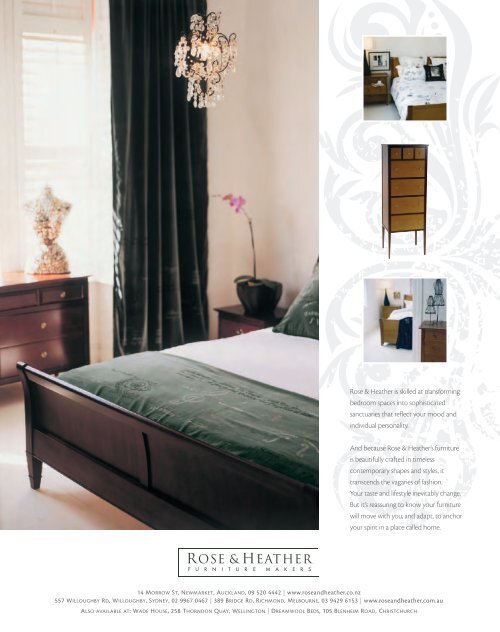13489 Habitat8 Book.indb - Resene
13489 Habitat8 Book.indb - Resene
13489 Habitat8 Book.indb - Resene
You also want an ePaper? Increase the reach of your titles
YUMPU automatically turns print PDFs into web optimized ePapers that Google loves.
50 |<br />
beginner’s guide to...<br />
words: Mary Searle<br />
tips: floral designers Megan Dickinson, Auckland, and Helen Hebberd, Nelson<br />
flower power<br />
Some more tips to keep your cut flowers looking good.<br />
> Start by purchasing good quality, fresh flowers. If you’re<br />
picking flowers from your garden, try to do so in the<br />
cool of morning or after sunset. Select flowers in bud<br />
rather than fully open.<br />
> Remove all leaves that will appear below the water level,<br />
otherwise they will rot and pollute the water. Re-cut the<br />
stems on a diagonal using a sharp knife or scissors, and<br />
plunge them into fresh, cold water. Allow them to sit<br />
in the water for at least an hour before arranging. By<br />
cutting stems on a diagonal, you expose the maximum<br />
surface area to take up water.<br />
> When selecting flowers, work in odd numbers, for<br />
example, three, five or seven of each type of flower. If<br />
you cannot decide what combination of flowers to use,<br />
just purchase one type of flower in bulk. One item en<br />
masse is foolproof.<br />
> Certain flowers last longer in water than others –<br />
alstroemerias, lilies and tulips will look good for ages,<br />
whereas roses can go off quickly if not looked after, and<br />
irises don’t last long at all.<br />
> Like people, different flowers have their own particular<br />
quirks. Some, such as peonies and water lilies, close as<br />
night. Others, like tulips and anemones, will continue<br />
to grow after being picked and will need to have their<br />
stems trimmed every couple of days. And others,<br />
gerberas for instance, will turn to face the light.<br />
> Combining the vase with the flowers is very important.<br />
The colour, form and height of the vase will determine<br />
what flowers you can use in it.<br />
> Rather than dotting the different flowers evenly<br />
throughout the arrangement, group types together in<br />
bunches, two or three at a time.<br />
> Be aware that different colours create different effects.<br />
Blues are receding colours and consequently are not<br />
good at night. Reds and purples have a feeling of<br />
opulence, yellows are bright and cheerful while greens<br />
are restful.<br />
> A monochromatic colour scheme is very dramatic,<br />
yet soothing, as there’s not too much for the eye to<br />
take in.<br />
> Add different textures to the arrangement for more<br />
interest – rough, smooth, fluffy, shiny, twiggy and<br />
prickly. Rose hips, seed pods, fruit and gum nuts can<br />
also look good.<br />
> Keep the water topped up daily and change it every<br />
second day. Keep flowers out of direct sunlight and<br />
ensure the room is well ventilated, especially in summer,<br />
to prolong the life of the flowers.<br />
<strong>Resene</strong><br />
Geneva<br />
<strong>Resene</strong><br />
Sargent Pepper

















